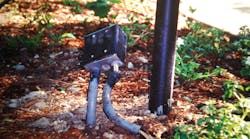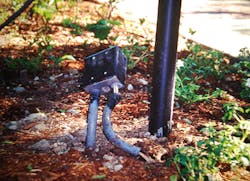How well do you know the Code? Think you can spot violations the original installer either ignored or couldn't identify? Here's your chance to moonlight as an electrical inspector and second-guess someone else's work from the safety of your living room or office. It's your turn to identify the violation.
Hint: Broken pipe dream
Find the Answer
This is an example of what happens when you try to use PVC pipes as the only means to support a box. Inevitably, the pipes will break, and the box will end up just flopping around. This now leaves the cables exposed and susceptible to physical damage. Damaged cables can greatly increase the shock hazard level.
Section 352.12(B) prohibits PVC pipe from being used to support luminaires or equipment other than conduit bodies as described in Sec. 352.10(H). Boxes are not conduit bodies and cannot be supported by the PVC pipe.
Section 314.23(E) permits rigid metal conduit (RMC) or intermediate metal conduit (IMC) to be used as a means of support for enclosures not greater than 100 cu. in. where two conduits are threaded wrenchtight into the enclosure and the conduits are supported within 3 ft of the enclosure, or within 18 in. of the enclosure where all the pipes enter the enclosure on the same side.





